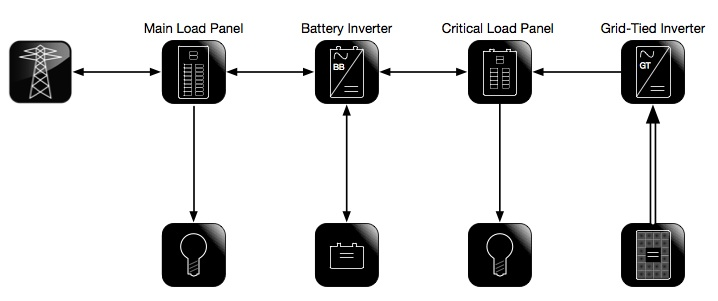Falling costs paired with new revenue streams available to residential and commercial owners is driving storage deployments to new highs.
 Retrofitting Solar PV with Energy Storage
Retrofitting Solar PV with Energy Storage

Contributed by | CivicSolar, Inc
Solar PV and energy storage are increasingly mentioned in the same breath. Falling costs paired with new revenue streams available to residential and commercial owners is driving storage deployments to new highs. Although many of these solar + storage systems are new deployments a significant opportunity for warm leads lies in customers that already have PV installed at their home or business. This article will cover the basic principles of adding energy storage to an existing PV system.
System Design

A basic block diagram showing an AC coupled solar + storage system.
Solar + storage systems fall into two buckets; AC coupled and DC coupled. In DC coupled system current flows from the module strings to a hybrid inverter or charge controller then to the batteries for charging. When power from the batteries is needed the hybrid inverter or battery-based inverters converts the DC current to AC for use in the home or business. For a customer with an existing PV system DC coupling is usually not a good option. Converting to a DC coupled system could require substantial rewiring (both on and off the roof) and deem the existing PV inverter worthless.
Instead, contractors should persuade their existing PV customers to consider an AC coupled solution should they opt to add storage. In doing so the PV inverter remains within the system to send AC current from the PV to the battery based inverter (as can be seen in the block diagram above). By preserving the PV inverter wiring on the roof can be left alone and the remainder of the installation can be limited to the utility room or point of interconnection.
For a more in depth comparison of AC and DC coupling see our article HERE.
Installation
Most existing PV system are tied into the main service panel of the building. In some instances the point of interconnection is on a subpanel or a load-side connection of the service conductors. Whatever the case, to retrofit an AC coupled storage system, the PV inverter must be installed such that it is isolated from the grid during an outage by the battery based inverter. To do so, a critical loads panel is added to the facility where the PV inverter is interconnected. This panel will also contain the loads to be backed up in the event of a grid outage.
Other configurations using the main service panel as the common panel are also possible with the use of an automatic transfer switch.
Choosing a Battery Based Inverter
If the retrofitted AC coupled storage system is to be operational in a grid backup mode, it is important to ensure the PV inverter and battery inverter communicate effectively. If they do not, the PV system could overcharge the batteries during a grid outage when local loads are minimal. To ensure optimal operation be sure the PV inverter is capable of frequency shifting curtailment or Sunspec compliant.
Investment Tax Credit
For information on the tax incentives available to storage systems see our previous article HERE. Relevant to the discussion of a retrofit, a storage system installed in conjunction with an existing PV system can qualify for the 30% ITC if charging is performed by the solar system. Contact your CivicSolar account manager for assistance designing a retrofit storage system.
The content & opinions in this article are the author’s and do not necessarily represent the views of AltEnergyMag
Comments (0)
This post does not have any comments. Be the first to leave a comment below.
